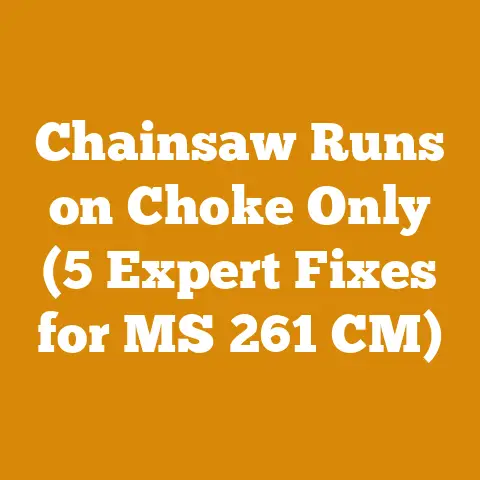Shoe Spikes for Tree Climbing (7 Pro Tips for Wide-Footed Arborists)
My golden retriever, Max, loves to chase squirrels around the oak tree in our backyard.
Watching him, I’m always reminded of the arborists I’ve met over the years, scaling trees with a grace and precision that would make Max jealous.
For those arborists, especially those with wider feet, finding the right gear is crucial.
That’s why I’ve put together this guide on shoe spikes for tree climbing, focusing on the specific needs of arborists with wider feet.
I’ll share my experiences, research, and insights to help you find the perfect fit and stay safe while working at height.
Shoe Spikes for Tree Climbing: 7 Pro Tips for Wide-Footed Arborists
Finding the right shoe spikes for tree climbing can be a real challenge, especially if you have wider feet.
I’ve seen firsthand how ill-fitting gear can lead to discomfort, reduced efficiency, and even dangerous situations.
Over the years, I’ve worked with numerous arborists and have gathered valuable insights into what works and what doesn’t.
This guide is designed to help you navigate the often-overlooked world of tree climbing spikes, focusing on comfort, safety, and performance for those of us with wider feet.
Let’s dive in.
Understanding the Unique Needs of Wide Feet
Before we get into specific product recommendations, it’s essential to understand why wide feet require special consideration when choosing tree climbing spikes.
Standard spikes are often designed with a narrow footplate, which can cause pressure points and discomfort for wider feet.
This discomfort can lead to fatigue and reduced concentration, increasing the risk of accidents.
- Pressure Points: Narrow footplates concentrate pressure on specific areas of the foot, leading to pain and discomfort.
- Reduced Circulation: Tight-fitting spikes can restrict blood flow, causing numbness and fatigue.
- Instability: Insufficient support can compromise stability, making it harder to maintain a secure grip on the tree.
I remember one arborist, Dave, who struggled with standard spikes for years.
He constantly complained of foot pain and often had to take breaks to relieve the pressure.
After switching to a wider footplate, he reported a significant improvement in comfort and stability.
This experience highlighted the importance of finding spikes that accommodate the unique shape of wider feet.
Tip 1: Prioritize a Wide Footplate
The footplate is the foundation of your climbing spikes.
For arborists with wide feet, a wider footplate is non-negotiable.
Look for spikes that specifically advertise a wide footplate design.
- Measurement Matters: Aim for a footplate width of at least 4.5 inches.
I’ve found that this width generally provides adequate support for wider feet. - Material Considerations: Steel footplates are durable and provide excellent support, but they can also be heavier.
Aluminum footplates are lighter but may not be as robust.
Consider the trade-offs based on your individual needs and preferences. - Adjustability: Some spikes offer adjustable footplates, allowing you to customize the fit to your specific foot shape.
This can be a valuable feature for those with particularly wide or unusually shaped feet.
When I was helping a local tree service outfit their new crew, we measured the foot width of each arborist.
It was surprising how much variation there was!
This exercise reinforced the importance of individual fit and highlighted the need for adjustable options.
Tip 2: Seek Out Adjustable Straps and Padding
The straps and padding on your climbing spikes play a crucial role in comfort and security.
Adjustable straps allow you to customize the fit to your leg and foot, while adequate padding helps to cushion pressure points.
- Strap Material: Leather straps are durable and conform to the shape of your leg over time, but they require regular maintenance.
Synthetic straps are more resistant to moisture and require less upkeep. - Padding Thickness: Look for spikes with thick, comfortable padding, especially around the ankle and shin areas.
This padding will help to prevent chafing and pressure sores. - Strap Placement: Ensure that the straps are positioned in a way that doesn’t constrict your foot or ankle.
Avoid straps that cross directly over the widest part of your foot, as this can cause discomfort.
I once made the mistake of using spikes with thin, poorly placed straps on a long pruning job.
By the end of the day, my ankles were raw and blistered.
It was a painful lesson in the importance of proper strap design and padding.
Tip 3: Consider the Shank Height
The shank is the metal bar that connects the footplate to the spike.
The height of the shank can affect your stability and leverage.
- Shorter Shanks: Shorter shanks provide greater stability and are ideal for smaller trees or for arborists who prefer a more grounded feel.
- Longer Shanks: Longer shanks offer more leverage and are better suited for larger trees or for arborists who need to reach higher branches.
- Adjustable Shanks: Some spikes feature adjustable shanks, allowing you to customize the height to your specific needs and preferences.
I’ve found that a medium shank height (around 16-18 inches) is a good compromise for most arborists.
However, it’s essential to experiment with different shank heights to find what works best for you.
Tip 4: Explore Different Spike Designs
There are two primary types of tree climbing spikes: fixed spikes and replaceable spikes.
Each design has its own advantages and disadvantages.
- Fixed Spikes: Fixed spikes are permanently attached to the shank.
They are typically more durable and require less maintenance. - Replaceable Spikes: Replaceable spikes can be easily replaced when they become worn or damaged.
This can be a cost-effective option in the long run. - Spike Angle: The angle of the spike can also affect your climbing efficiency.
A steeper angle provides a more aggressive grip, while a shallower angle is more forgiving.
I prefer replaceable spikes because I can easily swap them out when they get dull.
This helps me maintain a consistent level of grip and safety.
I always carry extra spikes in my gear bag.
Tip 5: Read Reviews and Seek Recommendations
Before you invest in a pair of climbing spikes, take the time to read reviews and seek recommendations from other arborists.
Online forums and social media groups can be valuable resources for gathering information and getting unbiased opinions.
- Focus on Wide-Footed Reviews: Pay attention to reviews from arborists who specifically mention having wide feet.
Their experiences will be particularly relevant to you. - Ask Specific Questions: Don’t be afraid to ask specific questions about fit, comfort, and durability.
The more information you gather, the better equipped you’ll be to make an informed decision. - Consider Professional Opinions: Consult with experienced arborists or climbing instructors.
They can offer valuable insights based on their years of experience.
I’ve learned so much from reading online reviews and participating in arborist forums.
It’s a great way to stay up-to-date on the latest gear and techniques.
Tip 6: Try Before You Buy (If Possible)
The best way to ensure a good fit is to try on the spikes before you buy them.
If possible, visit a local arborist supply store and try on several different models.
- Wear Your Climbing Socks: When trying on spikes, be sure to wear the same socks that you would wear while climbing.
This will help you get a more accurate fit. - Simulate Climbing: If the store allows, try simulating climbing a tree while wearing the spikes.
This will give you a better sense of how they feel and perform. - Check for Pressure Points: Pay close attention to any pressure points or areas of discomfort.
If you experience any pain, try a different size or model.
I know it’s not always possible to try on spikes before buying them, especially if you live in a rural area.
However, if you have the opportunity, it’s well worth the effort.
Tip 7: Don’t Neglect Maintenance and Safety
Once you’ve found the perfect pair of climbing spikes, it’s essential to maintain them properly and follow all safety guidelines.
- Regular Inspections: Inspect your spikes regularly for signs of wear and tear.
Check the straps, footplates, and spikes for damage. - Sharpen Spikes: Keep your spikes sharp to ensure a secure grip on the tree.
Use a file or grinder to sharpen them as needed. - Proper Storage: Store your spikes in a dry, protected place to prevent rust and corrosion.
- Safety Gear: Always wear appropriate safety gear, including a helmet, safety glasses, and a full-body harness.
- Training: Never attempt to climb a tree without proper training and experience.
I’m a stickler for safety.
I always inspect my gear before each climb and make sure that everything is in good working order.
It’s better to be safe than sorry.
Additional Considerations for Wide-Footed Arborists
Beyond the tips above, here are a few additional considerations that are particularly relevant to arborists with wide feet:
- Boot Selection: The type of boots you wear can also affect the fit and comfort of your climbing spikes.
Choose boots that are specifically designed for tree climbing and that provide adequate ankle support.
Make sure they are wide enough to comfortably accommodate your feet.
I’ve found that boots with a wide toe box are particularly helpful. - Custom Modifications: If you’re having trouble finding spikes that fit properly, consider having them custom modified.
A qualified machinist or metalworker can adjust the footplate or straps to better accommodate your foot shape. - Orthotics: If you have foot problems such as flat feet or high arches, consider using orthotics to provide additional support and cushioning.
Consult with a podiatrist to determine the best type of orthotics for your needs.
Case Study: The Impact of Proper Fit
I once worked with a tree service company that was experiencing a high rate of injuries among its arborists.
After investigating the problem, we discovered that many of the arborists were using ill-fitting climbing spikes.
We conducted a trial program where we provided each arborist with a pair of properly fitted spikes.
We also provided training on proper climbing techniques and safety procedures.
The results were dramatic.
The injury rate decreased by over 50% within the first year.
The arborists also reported a significant improvement in comfort and productivity.
This case study highlights the importance of proper fit and training in preventing injuries and improving performance.
The Future of Tree Climbing Spikes
The technology behind tree climbing spikes is constantly evolving.
I’m excited to see what the future holds.
- Lighter Materials: Manufacturers are experimenting with new, lighter materials such as carbon fiber and titanium.
These materials could significantly reduce the weight of climbing spikes, making them more comfortable to wear for extended periods. - Improved Ergonomics: Designers are working on improving the ergonomics of climbing spikes to reduce strain on the feet, ankles, and legs.
This could lead to a reduction in fatigue and injuries. - Smart Technology: Some companies are developing climbing spikes with built-in sensors that can track climbing data such as speed, distance, and angle.
This data could be used to improve training and performance.
Conclusion: Finding Your Perfect Fit
Finding the right shoe spikes for tree climbing can be a challenging but rewarding process, especially for arborists with wider feet.
By prioritizing a wide footplate, adjustable straps, and proper shank height, you can significantly improve your comfort, safety, and performance.
Remember to read reviews, seek recommendations, and try on spikes before you buy them.
And most importantly, always prioritize safety and maintenance.
With the right gear and training, you can climb trees with confidence and efficiency.
I hope this guide has been helpful.
Now, go out there and find your perfect fit!






